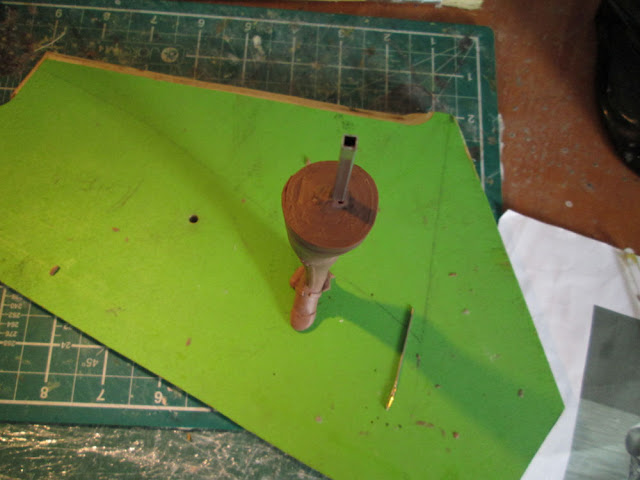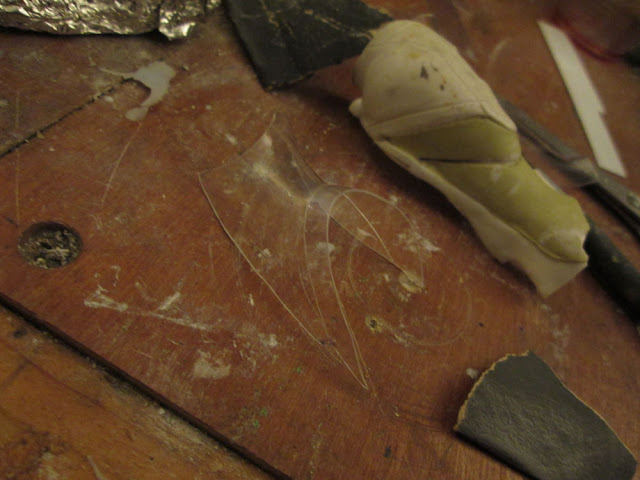Going into this project I knew it would be fairly difficult. It's one of those projects which can be deceptive. Looking at plans I'd think - hey, no problems here, but there were some extra tricky bits.
Edi is a robot, she has smooth surfaces, transparent areas and areas of tight mechanical detail. This was going to be a tricky sculpt and a chance to finally experiment with Vacuforming. Let's get started! (if you want to see more finished pictures - skip to the end.)
Sculpting the body

The first thing is to lay down the armature and proportions. I'd decided to sculpt the entire piece in monster clay. Using a firmer clay (other than Super Sculpey or even the firm version of that) would mean I could get straighter, flatter surfaces much easier.
Monster Clay is quite hard and unlike the regular Super Sculpey does not deform easily from accidental finger presses or little knocks. For me it meant I could get a much stiffer base to work with.
Monster Clay never sets in a permanent fashion. It can be heated to become more malleable but when it cools it returns to an almost wax like state. Because of this it means this piece will also have to be molded in silicone - part of the plan of course as the resulting figure would have some thin areas and having a final figure made of polyurethane resin is much more durable than baked Super Sculpey.
To facillite molding I made sure the armature could be disassembled easily. I got some square aluminium rods in 2 sizes so that they could slide into each other. Having a square shape also means parts can't rotate. I used Milliput to join the elements of the armature together. A reference photograph of the desired pose was used to position the limbs.
I love Monster Clay. I've used it for a few projects now and it's great. I have a small hand held heat gun which warms the clay perfectly.
At this point I start cutting away the key areas. The central torso area has a lot of detail but also a clear covering. I cut back this area more than I needed too so that when the clear material is added its flush with the topmost surface.
Detail is stating to be added at this point adding bits of detail as I go.
I found a small circular metal piece for the top of the chest/base of the neck area which was just the right size - much better than trying to carve out a perfect circle in monster clay by hand.
Towards the end of the body sculpt some light smoothing is done with white spirit and a soft brush. Small pits are filled with more monster clay and re-smoothed.
To get a circle into the hip area of the model I pressed a washer into the clay.
She disassembles!
Admittedly the pictures jump a bit and a whole head has appeared - this makes it look easy but the head anything but. The scale of the head makes facial features much more difficult. There are many more pictures of small amendments to the face to make her look right, but I'll spare you the pain of scrolling through those and just show the highlights here!
A piece of styrene was used to position where the visor would go.
The main body is prepped for molding by being inserted into a sheet of MDF. She is raised from the surface to make sure I capture the bottom of where the legs join the body. The two mating surfaces needed to match.
The legs and body were cast in a Polyurethane Resin from DWR plastics - it's pretty good stuff.
A couple of passes of primer and sanding to make sure everything is level and there are no weird dips.
Vacuforming
There was only going to be one way to get a transparent surface shaped in exactly the way I needed it and that was to use a Vacuformer.I'd always been meaning to give it a go and so this was my chance. An important note though, my vacuformer isn't going to win any awards in 'Great Tools on the Cheap' magazine.
My vacuform 'machine' is called the Supa-Suck/ It is 2 sheets of MDF with a frame around the outside to form a void inside. The top most layer has many many holes drilled into it to allow the air to be pulled through. There are some good resources for building your own Vacuform machine on the web like here and here - I certainly wouldn't follow my example!
My vacuformer isn't very deep. That's because I'm only using a standard house vacuum, not a shop vac - so I was unsure how much of a vacuum I'd be able to get.
A rough hole is cut into the button to stick the vacuum nozzle through. It's duct taped into place to stop air leakage.
A metal frame to hold the plastic was made from L strips of aluminium and some corner brackets.
The entire frame then fits over the former.
To form the masters to pull from a quick rotocast was made of the torso area and was covered in Milliput (the green stuff) in the appropriate areas. This was then sanded smooth.
The torso was cut in half and positioned onto the former. This wasn't a perfect pull - but as a first attempt it at least proved it could work in theory. The masters themselves were raised up to make sure the plastic was pulled around the whole shape and not just some of it. You'll also notice on the right that the plastic has pulled away from the frame here - this was because there wasn't enough plastic for the frame to grip on this side. Also ignore that random bit of tin foil that's on the peep there - I was using this to pack the hollow cast to protect it from collapsing (which the suction is unlikely to do in this case.)
I used about an A5 size of .5mm PETG clear plastic heated in a halogen oven for 4 minutes at 160 degrees centigrade. Your numbers may vary.
You'll notice that there is a bit of webbing - raising the masters away from the former just a bit stops any (inevitable) webbing from ruining the pull.
Afterwards I cut the pieces out with a scalpel and sanded them just a bit with a dremel to be the correct shape.
Painting
The figure was painted in Tamiya acrylics with an airbrush. I'd found a couple of premixed colours which were pretty much the right colour.First passes and masking.
The center torso section was weathered with a Tamiya weathering kit (I've just noticed this project is Tamiya-city!) I pretty much over-detailed this section so that when the tinted transparent section went over it the detail could still be seen.
The visor is clear PETG plastic painted in a few light coats of Vallejo Orange Rust. To join the visor securely two ear pieces were cut - one with a slot for the visor and another to stick on top to hide the join.
The gun was made with Styrene sheets. It's pretty small!
Pieces coming together!
The Base and Lighting
For the base a few casts were made in a small lid I had lying around which had an interesting edge to it. A few layers of this was cast which gave an interesting effect - almost like it'd been turned on a lathe! A transparent piece of PETG was glued to to top to allow the LED's to shine through and inbetween the gaps of the tiles.
A mold was taken of some small ceramic tiles I had (I only had 4) and duplicates were cast in resin.
Four blue LED's were positioned under the transparent lid and the whole thing was sealed shut.
Finished Figure
Thanks for looking / reading



















































